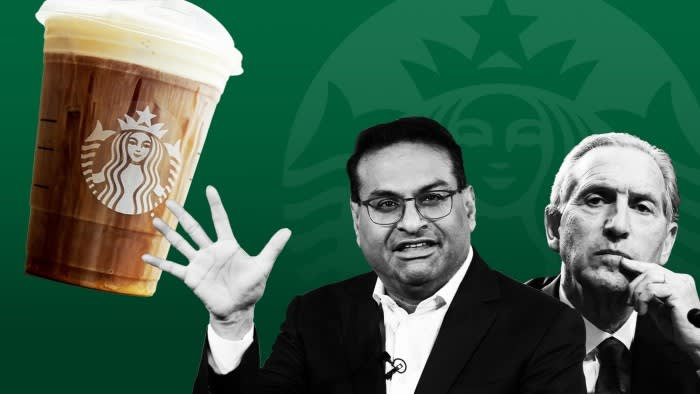When Laxman Narasimhan took over as Starbucks chief executive last year, he had a tough act to follow. Three acts, in fact.
His immediate predecessor, Howard Schultz, had been serving as CEO for the third time since he started building the world’s largest coffee chain in the 1980s. Narasimhan was an outsider, a former McKinsey consultant who had most recently run the UK consumer products group Reckitt Benckiser.
Narasimhan is now under pressure from at least four sides. Elliott Investment Management, an aggressive investor activist, has been pushing for changes after a slide in Starbucks shares. His managers have been locked in talks with a union of baristas seeking higher pay and better conditions.
He has presided over the company’s first decline in comparable sales since early in the coronavirus pandemic. Inflation-squeezed consumers have been buying fewer drinks and meals; some have boycotted Starbucks over what they believe to be its position on the Israel-Hamas war; and sales in China, a critical growth market, have been shrinking.
Analysts expect another fall in same-store sales when Starbucks reports its third-quarter results on Tuesday.
Meanwhile, Schultz, 71, has been critiquing from the sidelines. “I think we’re not at our best right now,” Schultz told the Acquired podcast last month, saying he was “not a messiah” but still knew Starbucks’ inner workings “better than anyone else”.
Narasimhan was named CEO in September 2022 but did not succeed Schultz until March 2023. He spent the intervening months touring cafés, often working behind the counter with a green apron on, learning to make such drinks as a triple-tall, blonde, extra-whipped pumpkin-spice latte.
Seven months later he unveiled a strategy with a name evoking one of its custom orders, “Triple Shot Reinvention with Two Pumps”. The plan includes opening eight new stores a day around the world, enlisting tens of millions of new customers in its rewards programme, cutting $4bn in costs and boosting baristas’ pay.
Afterwards, “results were almost immediately below expectations”, JPMorgan Chase analysts wrote earlier this year. The company cut financial guidance in January and again in April.
“The thing we didn’t do enough of is really attack the occasional customer with delivering and communicating value to them in a more aggressive manner,” Narasimhan explained to CNBC in May.
Schultz responded days later with a LinkedIn post lamenting Starbucks’ “fall from grace”.
“Senior leaders — including board members — need to spend more time with those who wear the green apron,” he said, not mentioning Narasimhan’s months under his tutelage.
Schultz is Starbucks’ sixth-largest shareholder, and some employees remain fiercely loyal to him. Others do not: Narasimhan inherited tense labour relations as workers, complaining of understaffing and low wages, organised the first Starbucks store in late 2021. The Workers United union, which Schultz opposed, now represents baristas at more than 470 US outlets.
The company and Workers United sued each other days after the Hamas attack on Israel last October, when the company said a pro-Palestinian social media post from the union harmed its reputation. Some customers have shunned Starbucks in response, with restaurant chain operator Alsea warning investors last week it was “facing some pressures” at licensed Starbucks locations in France and the Netherlands, “due to the boycotts against American brands”.
Starbucks, which has no stores in Israel, has not quantified the impact of what Narasimhan has called “misinformation” about its stance on the Israel-Hamas conflict. The union and the company announced a framework in February to resolve their differences, with Starbucks saying it hopes to have contracts ratified this year.
Ambitions in China, where Schultz set the target of opening a store every nine hours, are also being challenged by cheaper local chains such as Luckin, which now has more than double the number of outlets as Starbucks in the country, according to JPMorgan.

Starbucks has held to its premium pricing in China, but elsewhere there are signs of it focusing harder on “value”. In the US, it has increased promotions such as “50% Off Fridays” in May and $5 coffee-and-croissant pairings. It has also made changes to cut customer wait times and relieve burdens on workers as they fill complex orders at busy times of day.
“In the current consumer environment, we are laser focused on what we can control,” a spokesman said. “We are executing our action plans, which include making improvements to our store operations, delivering compelling new products, and ensuring the experience we create for our customers everywhere is worth it every time.”
Narasimhan has also reorganised Starbucks’ senior ranks along geographic lines “to accelerate company reinvention”, naming Michael Conway the CEO of North America and Brady Brewer CEO of international in March. Former executives say both are viewed internally as being primed as potential future CEOs.
Depending on Starbucks’ performance, more changes may be afoot.
“My conversations with investors are pointing to an increased level of dissatisfaction with management,” said Danilo Gargiulo, a restaurant analyst at Bernstein: “I also think it’s not easy to operate when you have a founder still in the shadows who is governing without any clear role within Starbucks.”
How Narasimhan handles the Elliott negotiations will be a test of whether he can satisfy other investors, who have seen $30bn in market capitalisation disappear during his tenure. Schultz has opposed a settlement with the activist, the Financial Times reported last week. He and Elliott declined to comment.
Schultz has said he has no plans for a fourth act, telling the Acquired podcast: “I’ve made it clear to Laxman, Howard Schultz has no desire or intent to return as CEO of Starbucks.”
Some are sceptical. “Starbucks is his baby,” one former senior executive said of Schultz. “He just can’t let it go and hand it over fully to someone else.
“There’s always a risk he’ll come back.”



